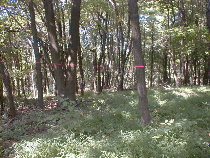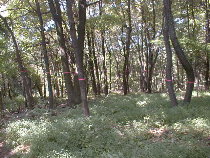 The minute I stepped off the city’s grid and headed into the woods, I lost my way.
The minute I stepped off the city’s grid and headed into the woods, I lost my way.
I was at the Schuylkill Center for Environmental Education, looking for Edward Dormer‘s Fringe Festival installation, “CUT HERE: Instruction, Command, Option.”
The map didn’t seem to conform to the paths and the land, although I’m sure it really did. I headed out on a path that turned out to be the roadway back to the city. Oh, no.
Retracing my steps, I still couldn’t find the path, but did happen upon my dentist’s former assistant, sitting right there at a picnic table, ready to help me. Aah, life is stranger than fiction.
It turns out, the path was blocked by a chain intended to block vehicles, but not people, and I couldn’t see the path for the chain.
 The installation sounded kind of simple-minded in the description, but once I found it, I was enthralled by the mysteries of spatial relationships. Dormer was imposing a straight line in the forest, using fluorescent tape tied around the trees to demark a horizontal plane and to emphasize the shifting topography.
The installation sounded kind of simple-minded in the description, but once I found it, I was enthralled by the mysteries of spatial relationships. Dormer was imposing a straight line in the forest, using fluorescent tape tied around the trees to demark a horizontal plane and to emphasize the shifting topography.
The title of the piece suggests the piece is about cutting down trees and land development.
But what interested me was how my shifting perspective showed the tapes aligned if I stood in some spots, but not aligned when I stood in others.
It reminded me of my confusion away from the city’s grid, even with map in hand. And it reminded me that the eye is a trickster, and three-point perspective merely a map for artists to get a grip on natural space.
As for the minimalist grid, I began to think that maybe it represented painting losing its perspective and looking for a roadmap out.









